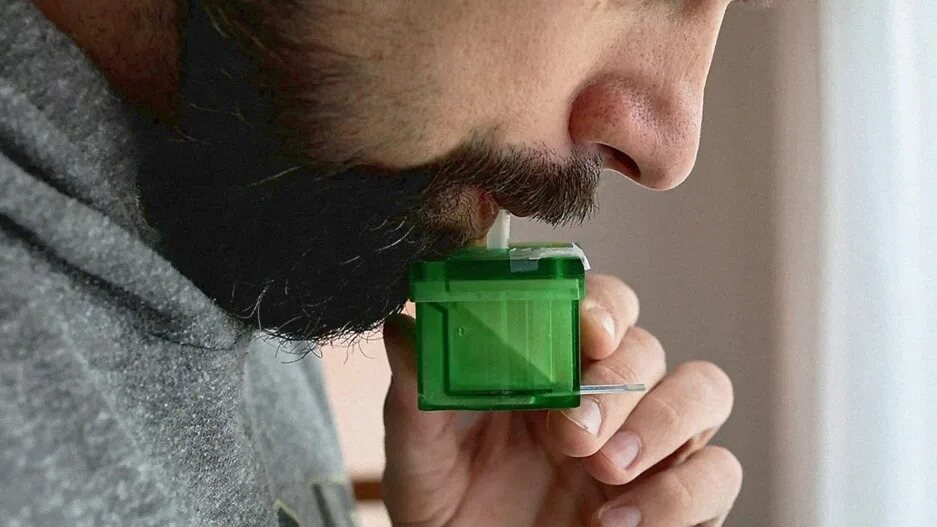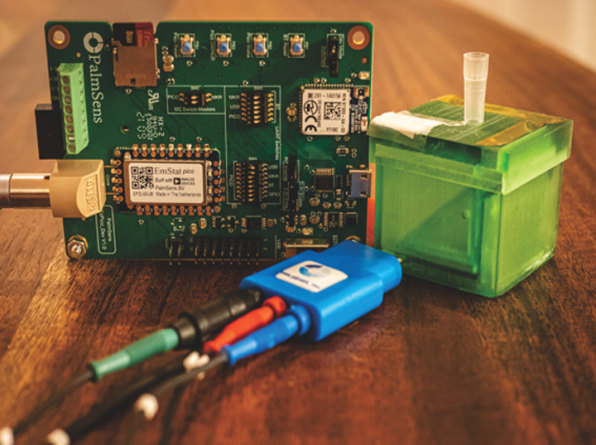- | 8:00 am
This COVID breathalyzer can detect the virus from a single breath
Researchers at Washington University designed a breathalyzer that could spell the end of nasal swabbing for Covid.

Getting tested for COVID-19 is a nightmare. You sneeze your way through an awkward nasal swab, swish your mucus in a tube, squeeze the liquid out into a miniature hole, wait 15 minutes, and decipher the results. Is it “C” for “control line” or “C” for COVID?
Since August 2020, researchers at Washington University in St. Louis have been working on a much simpler, non-invasive alternative that might be familiar to anyone who’s ever been pulled over for driving under the influence: a COVID breathalyzer. The current prototype consists of a 3D-printed box that can fit in the palm of your hand and is outfitted with a little straw. You blow into it, wait about 17 seconds, and read your result on a separate device that is still being developed but looks a bit like a Square contactless card reader.

According to a study recently published in the journal ACS Sensors, initial clinical studies suggest the device has a diagnostic accuracy of 95% (admittedly among only 36 people), but the study is ongoing and won’t be complete until November. If the breathalyzer is approved by the FDA, it could make screening at big music festivals, conferences, and sports venues a breeze. It could also revolutionize point-of-care, or any testing that isn’t done in a clinic. In theory, you could get tested at a pharmacy or at a clinic, get immediate results, then immediate treatment within minutes. (And if another pandemic strikes, it would certainly eradicate testing conga lines.)
The study coincides with the now customary COVID summer wave, with cases increasing by 12 percent to around 8,000 across the U.S. at the end of July. And though cases are generally much, much lower than previous years, experts say that COVID is here to stay—like the flu or RSV. As it happens, the breathalyzer can detect these viruses, too.
This isn’t the first COVID breathalyzer. Previous iterations include breathalyzers that take anywhere from three minutes to a full hour to provide results. But not only is this new device faster, it can also detect the presence of actual viral particles, not just volatile organic compounds (VOCs) that correspond with SARS-CoV-2. Rajan Chakrabarty, co-author of the study and an associate professor in the school of engineering at Washington University, explains that many breathalyzers on the market also require 10 to 15 breaths, which of course can tire out patients. “We were hoping it would take 6-8 breaths, and the clinical study was to test that out, and what we found is it was just a breath or two, tops,” he says.

That may be because of the device’s ingenious design. Chakrabarty says that the FDA advised the team to make a single-use device that didn’t have to be disinfected every time. As a result, the team began experimenting with 3D printing, which allowed them to manufacture the device quickly and easily, while keeping costs down for the consumer.
The team 3D printed the box, but inside it is where things get interesting. Once you blow into the tube, your breath condensates against a cold plastic surface—”like a cold mirror” says John Cirrito, another of the study’s authors. That surface is coated with a hydrophobic film and slanted at a 45-degree angle, so that when your breath hits the surface, it turns into tiny droplets that slide right off the surface onto an electrochemical biosensor located at the bottom. (By default, a piece of plastic is likely to be colder than your breath, but to facilitate condensation, the team says the final design will also come with a little pull tab that activates a chemical reaction inside the box to cool the surface, a bit like an instant cold pack.)
In many ways, the key to the breathalyzer’s scientific success lies in that biosensor, which the team repurposed from a biosensor that was originally created to test for Alzheimer’s in mouse brains. “I spent a lot of time learning electrochemistry and figuring out how to change these electrodes to detect different targets,” says coauthor Carla Yeude.
Earlier last month, the same team of researchers published another study about an air monitor that uses the exact same to detect COVID-19 variants in indoor air in about five minutes. The team is now working with a design firm to turn both prototypes into final products and expects to bring the devices to market within a year.








































